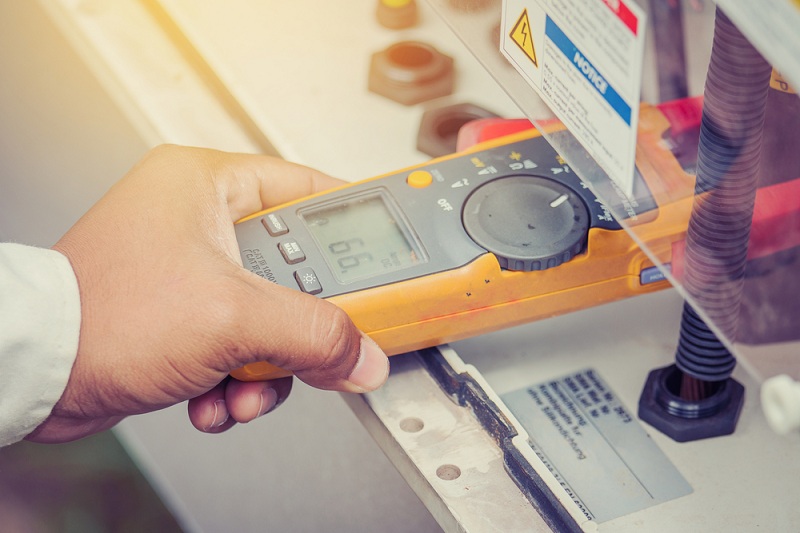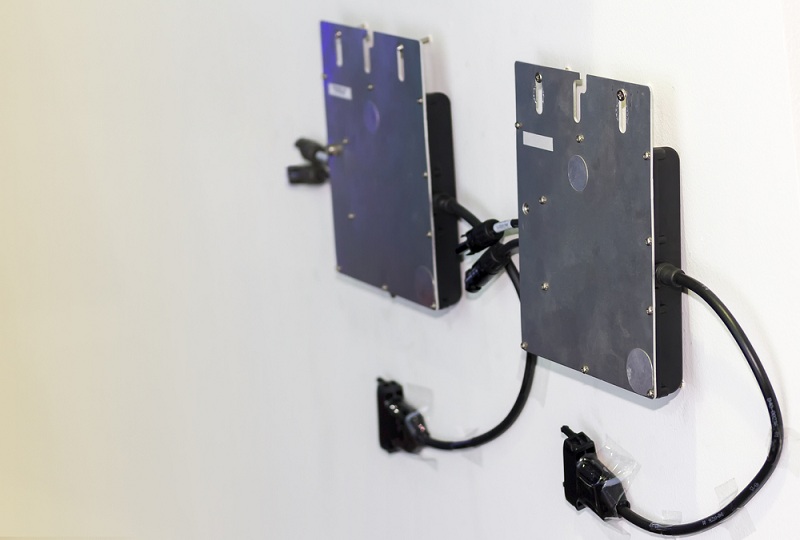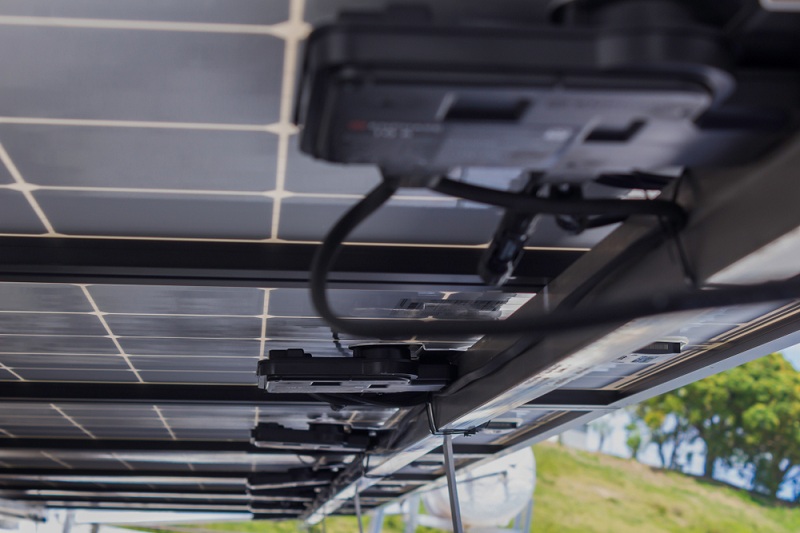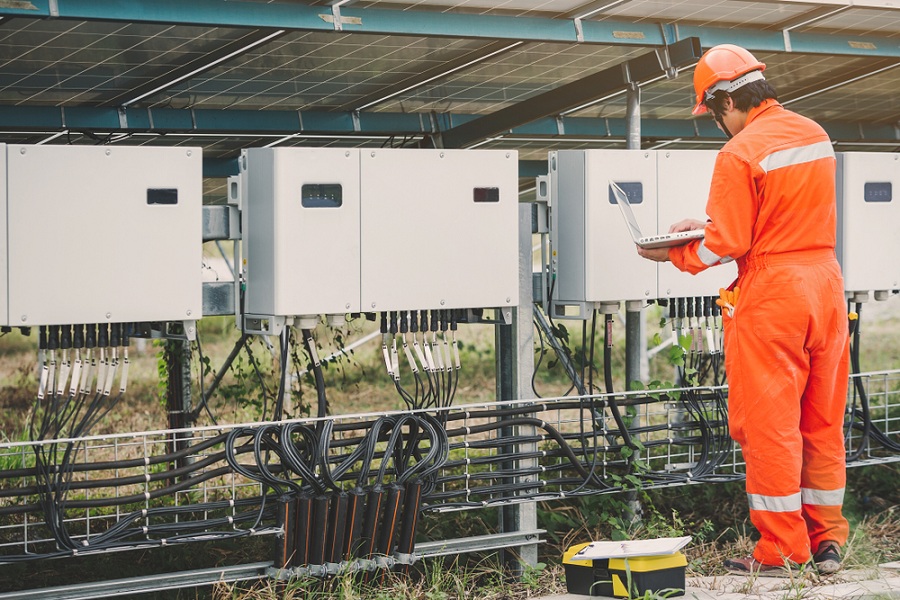A solar inverter has one primary job: converting DC power from solar panels into AC energy suitable for your house.
Over the past few decades, inverters have evolved to provide greater efficiency when converting solar power into electricity for use at home. Microinverters and string microinverters both perform this task for you as a solar owner, but they approach the problem from different angles.
We'll look at string inverter and microinverter technology from a closer perspective, comparing them to one another for their use in your solar energy systems.
What Is A String Inverter?
It’s a standalone device that usually sits near your main electrical panel and power meter.
Usually, there will be just one or maybe two string inverters per residential solar installation, depending on the total size of your solar panel array.
Strings inverter functions in a serial circuit, with there typically being six to twelve individual solar panels in what's known as a "serial circuit." SMA is a leader in manufacturing strings inverter systems.
Advantages Of String Inverters

Lower Probability Of Wiring Mishap
As many wires don't connect solar panels and string inverters. Therefore, there's less risk that an incorrectly wired string inverter will fail than there would be for a microinverter system.
Cost
Installing single-string inverters for a solar power system is less expensive than installing microinverters. Labor hours are reduced, and string inverters cost less than most microinverter systems.
Easy To Troubleshoot
One of the advantages of using a string inverter is the fact that you only require one of them to transform the DC current from your solar panel into an AC current. If any component fails in a solar panel array, it is most likely an inverting device (making troubleshooting relatively simple).
Disadvantages of String Inverters
More Difficult System Expansion
If you want to achieve maximum power output from a string inverter (or any other type), you need to ensure that it's operating at its peak efficiency. If you want to add extra capacity to your solar panel system, later on, you'll need to route them to a separate string inverter, which adds additional costs and complications.
System Monitoring
With a string inverter, panels do not have any additional components attached to them, so they're not able to provide panel-level insight.
While aggregate solar power generation can be seen, you won’t be able to see if any individual panels are having problems caused by cracks, bugs, or even small amounts of dust.
Efficiency In Partial Shade
As a result, since string inverter systems require solar cells to be wired in series (i.e., connected), if one solar cell's output is affected, so is the entire series of solar cells. If one section of a solar panel array is shaded most of the time, that could cause issues.
Shorter Lifespan
String inverter warranties range from eight to 12 years, whereas micro inverter warranties run for up to 25 years.
Optimizing your strings with a power optimizer. Adding a power optimizer can easily fix many of the problems associated with string inverters. Power optimizers are attached to the back of each photovoltaic (PV) module to minimize shading effects and maximize solar energy output.
Read more about power optimizers here.
What are Microinverters?

Microinverters operate similarly to string inverters, but they're usually placed under each solar panel on your rooftop. These microinverter devices are roughly the size of an internet modem.
A solar panel installation using microinverter technology has the same number of microinverter units as solar cells. (Note: Microinverter systems accept two or four photovoltaic modules.)
Enphase is a leader in the manufacture of microinverter systems. Enphase microinverters have been available for several years and have become an important part of their growing business. They've been researching how to best apply the concepts of Maximum Point Tracking (MPPT) to their components for improved solar photovoltaic (PV) production.
Standard inverter panels will limit the output of each individual solar module to its lowest-performing one. Microinverters, however, operate in a parallel circuit, so there is no need for them to be limited by their weakest component.
Each individual microinverters can take full advantage of the power production of every single panel.
Each microinverter generates electricity from solar panels and then feeds it into the local utility grid. Each solar panel and inverter combination can "do its best," and each contributes as much electricity as possible.
Advantages Of Microinverters
More Electricity
One of the main advantages of installing microinverters is the potential for increased yields from solar energy. One of the reasons why this is true is because there are small differences in current between solar cells.
If solar panels are connected in series, then the current through each panel is reduced to that of its lowest-performing neighbor.
Rapid Shutdown Capability
To protect first responders or firefighters working on roofs or servicing electric lines, new electrical codes require rapid solar systems to shut down before they reach dangerous voltages.
Microinverters meet these rapid shutdown requirements and have this capability built right into each module.
Suitability For Challenging Installation Conditions
If a solar system has different angles, for example, some panels face south, others face north, and others face west, then microinverters are the best option. Also, If you have shading issues from your roof or chimney, then a micro-inverter would be best.
When using solar power, the panels will produce different amounts of power at different times of the year. Still, microinverter technology will allow you to capture all available power from the sun. With a standard inverter, however, you will lose some of the power produced by the panels.
System Expansion Ease
If you wanted to expand your system in later years, adding microinverters would be easy to do one at a time. Each panel and micro-inverter can be easily added to an existing solar array without purchasing, installing, and maintaining any additional string inverters.
Panel-level Monitoring
With micro inverters, you can monitor the output of every single panel, whereas with a standard inverter, you only see the total output from the entire system.
Lifespan
Typically, microinverter systems come with 25-year warranty terms, while standard inverter systems usually offer 8 to 12-year warranty terms.
Microinverter technologies were once considered unreliable, but they now have caught up with the rest of the industry. The long warranty periods on microinverters show the manufacturer's confidence in its product.
To Summarize, Microinverter systems are worth considering if you have shading issues, panels face multiple directions, or you need to comply with rapidly shutting down requirements. If not, the cheaper standard inverter is usually better for money.
Disadvantages Of Microinverters

Cost
One of the disadvantages of microinverters compared to regular inverters is their high cost. They're usually $1,000 or more expensive than a string-inverting system for a typical 5 kW residential solar installation.
Maintenance
It may be difficult to detect which microinverter has failed, but once you've detected which one has failed, repairing and/or installing a replacement microinverter is not as simple as just popping in a new string inverter on the side of your home.
After installing solar panels, your solar installer needs to climb onto your rooftop, work with your rack system, unbolt the solar modules, and install a new microinverter to restore power to your house.
Amount Of Hardware On Your Roof
Because there's a microinverter connected to every solar panel on your roof, there’s quite an impressive amount of expensive metal equipment.
Miniature inverter circuits may act as miniature "lightning" rods. If you live in an area prone to storms and have a historic wooden building with shaky roofing material, you may want to consider not installing them.
String Inverters Vs Micro inverters: Which One Is Best For Your House?
Microinverters from most manufacturers claim they have a very low failure rates, but at SolarReview, we're not convinced by these claims.
Most important component in any solar system is the inverters. One of the most common issues with solar setups is an inverter malfunction. If I had to install twenty inverter systems instead of just one, then I might hesitate. If there were severe shade issues, I would only use this technique.
Microinverters allow you to monitor individual panels, but they don't provide the ability for the user to do so themselves. They only let the installer see the panel-based statistics from your computer and not you as a user unless you agree to pay for the higher-end service as an upgrade.
As a user, you only ever view system-wide (all at once) monitored values, not what happens to each individual panel. A skeptic might say that they do this so that people don't call them out when their inverters break down.
It's difficult to determine whether one or two inverters have failed when looking at system-wide monitoring data alone.
After saying this, however, I still prefer micro inverters, but if I were purchasing one, I would spend the extra cash for the capability to get panels-based analytics. If a string inverter fails then the entire system stops working, which is easy to notice.
It seems to me that there are many microinverter failures out on roofs where the clients don't even know they've had a failure.


